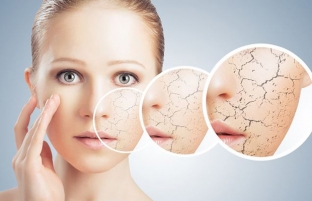With age, the skin changes - it gradually becomes drier, loses firmness and elasticity, increases its sensitivity. Accordingly, cosmetic care products should also change. People with sensitive facial skin are at risk of developing some dermatological diseases. Therefore, proper care and careful selection of products for the care of such skin is very important for them.
There are several classifications by which skin type is determined. The skin is classified according to photosensitivity, as well as depending on the function of the sebaceous and sweat glands.
Characteristic signs and causes of sensitive facial skin
The concept of “sensitive facial skin” very firmly established in our lives. Patients of cosmetologists complain about it more and more often, they write about it in magazines, speak at professional congresses, they produce special cosmetics for it.
For example, 40% of the US population is convinced that they have all the signs of such sensitivity. 70% of all women in Europe describe their skin as sensitive, but only 12% are actually. There are 4 types of sensitive facial skin, read more about them further on estet-portal.com. In most cases, the owners of such skin – blondes and redheads with very fair skin and blue or green eyes.
Their skin not only produces little lipids, but also has a very thin stratum corneum and very little protective pigment. Because of this, she is especially susceptible to all external stimuli, as well as internal stresses.
Some people have all the signs of “sensitivity” (irritation, redness and peeling of the skin) occur after the use of improperly selected cosmetics.
In others, such manifestations are noted when climatic conditions change – hot, cold, strong wind. Such a skin reaction is very often mistaken for an allergy or some kind of dermatological disease (for example, rosacea or seborrheic dermatitis). However, if for a long time such symptoms appear suddenly, for no apparent reason, it is most likely that we can talk about sensitive facial skin.

4 types of sensitive facial skin
The most “sensitive character” those areas of the face differ in which the skin is either anatomically too thin, or the so-called lipid barrier is lost or weakened. An example of such areas are the nasolabial region and the area around the eyes. It is no secret that irritations most often appear in these places.
Four types of sensitive facial skin have been identified in the French Research Center for Healthy Skin:
- In type I, irritation is associated with the intake of alcohol, certain foods, under stress, a sharp change in temperature.
- In type II, redness, a feeling of tightness of the skin appears while being in the cold, in the wind, under the air conditioner.
- In type III, all of the above symptoms are present, and red spots also occur when using cosmetics, washing with soap and water.
- And finally, in type IV, the presence of red spots on the skin is associated with the menstrual cycle or the onset of menopause in a woman.
What are the features of dry facial skin
Dry skin – this type of skin is usually thin, has small pores, and has a matte, dull tone. It is characterized by a low lipid content. In youth, this type of skin looks attractive: peach cheeks, lack of shine, imperceptible pores. But on such skin, wrinkles quickly form, especially around the eyes. Normal skin tends to become dry with age, and this happens on average after age 40.
The owners of such skin have to constantly moisturize and nourish it in order to look attractive. The pH level for dry skin is in the range of 3 to 5.5.
Do not confuse dehydrated and dry skin. These are different concepts. Dehydrated (flaky) can be both oily and normal skin. And dry skin lacks both lipids and moisture.
This is due to insufficient function of the sebaceous glands, which produce less lipids than required to form a natural protective film that prevents the skin from drying out. Moisture evaporates intensively from the upper layers of the epidermis if dry skin is not properly cared for.
Climate that is too hot or too cold makes skin dry more quickly. Sometimes it dries up so much that it begins to peel off, cracks appear on it, the skin becomes rough. In this case, one speaks of sensitive facial skin, and this has nothing to do with allergies.







Add a comment